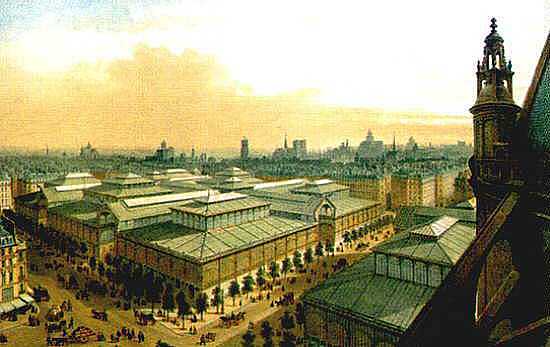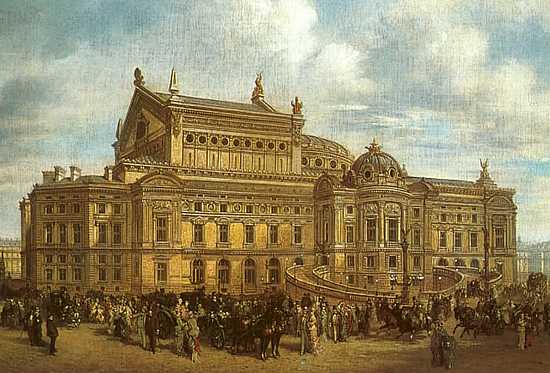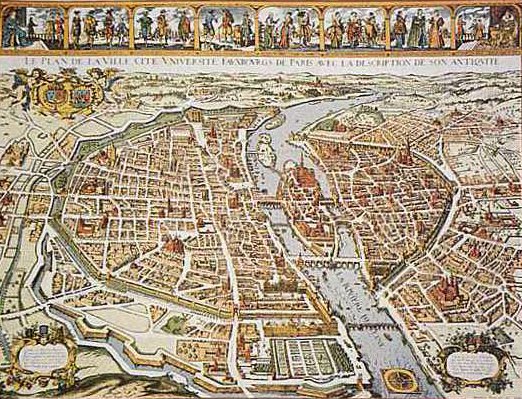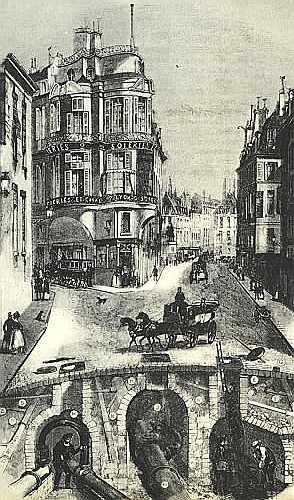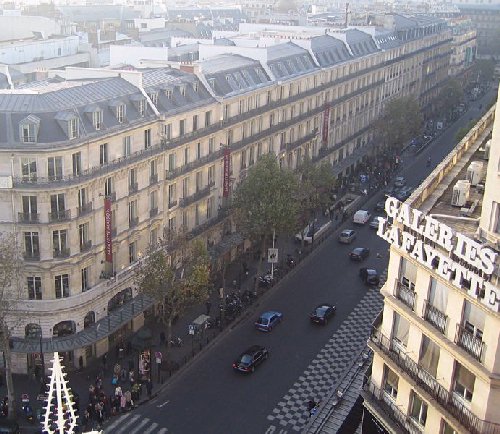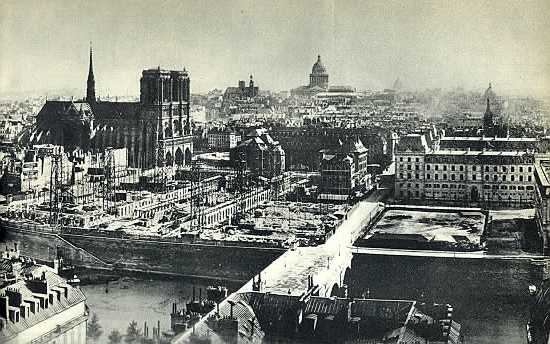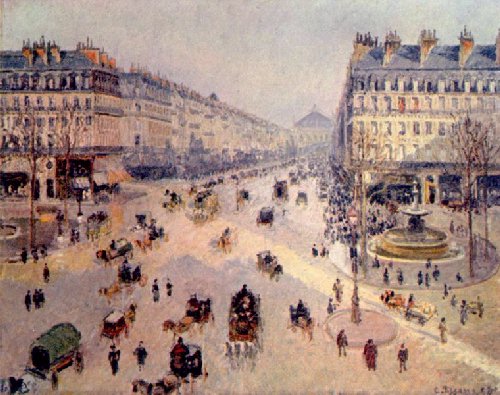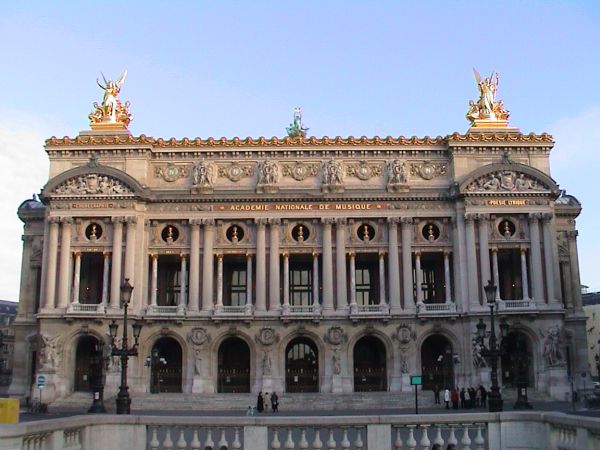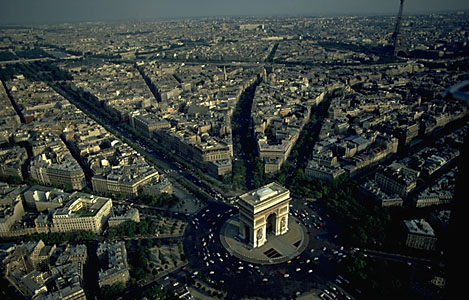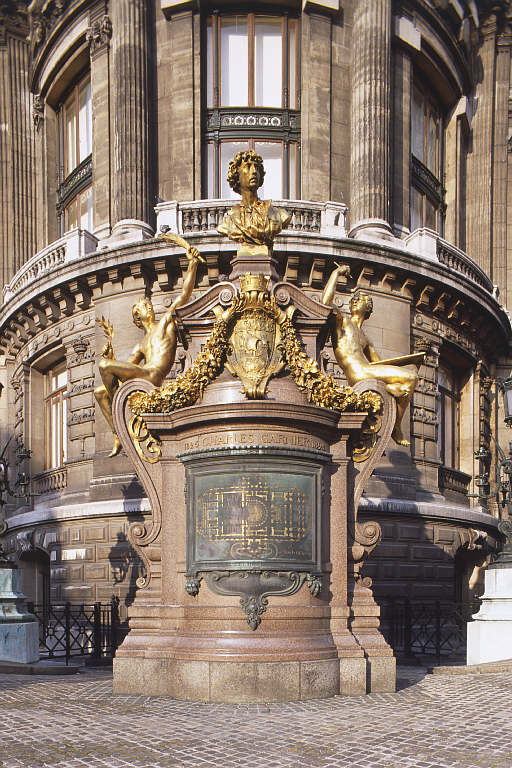| Haussmann's Paris
The Art History Archive - Architecture
Architecture in the Era of Napoleon IIIBy Emily Kirkman - 2007. During a time of industrial change and cultural advancement, Paris became the new home for many, overcrowding the ancient districts and spreading disease. The city, which had been untouched since the Middle Ages, was in dire need of reflecting the new modern ways and putting an end to the spreading medical epidemics. The tight confines of Medieval Paris were hindering the city’s potential for growth and desire to transform into a well-organized urban center. Napoleon III set about bringing order and structure to the chaotic, cramped city and putting an end to its' identity crisis. Baron Georges-Eugene Haussmann, chosen by Napoleon III to lead the project, created new roads, public parks, public monuments, as well as installing new sewers and changing the architectural façade of the city. With the aid of the public, Modernist Napoleon III set out to undertake one of the largest urban transformations since the burning of London in 1666.
Louis Napoleon III, who became emperor in 1852, had a great deal of interest in developing Paris into a new modern city after the Industrial Revolution.
The Second French Empire, ruled by Napoleon III, had complete control over the country, and he set out to begin construction on his plan that would bring Paris into the modern era and establish its’ dominance as a western city. With the induction of Baron Georges Haussmann as prefect of the Seine, Napoleon had an ally in the government to carry out the modernization. While neither one were trained in the arts, both men had ideas for how they wanted the city to look. Napoleon had a greater interest in the techniques and new materials that were to be used, while Haussmann paid more interest to the aesthetic quality of the modernization project. Yet both men adhered to the classical style, creating a metropolis of neoclassical wonder.
In 1853, Haussman had outlined and began construction on a series of basic projects that had been planned since the decision had been made to modernize the city. The projects included creating a north-south axis in the city, developing the quarters around the Opéra, as well as “the annexation of the suburbs to make them outer arrondissements, the sewer system, and the water supply.” In the early 1860s it is to be known that upon the completion of the original projects, new projects were put in to development, including annexing newer arrondissements, and putting the city into debt. Haussmann molded the city into a geometric grid, with new streets running east and west, north and south, dividing Medieval Paris into new sections. His plan brought symmetry to the city, something it was lacking beforehand. No Parisian neighborhood was left untouched by Haussman’s hand. “The new streets were also wider than most of their predecessors, for reasons of public health and traffic engineering.” During a time when the city was filled to the brim with people, disease was a large risk.
The widening of the streets would relieve the cramped city and allow for the people to get around more easily. It also allowed for an increase in height of the buildings, providing more room for the people of Paris to live and thrive in. Running alongside the new roads, which had been widened to accommodate the rising number of people living within the city limits, were rows of chestnut trees, which allowed Haussmann to maintain the geometric and symmetrical aesthetic that he had created with the new roads. And where he struggled to maintain his visual order, new public spaces and monuments were erected. In David P. Jordan’s article “Haussmann and Haussmannisation: The Legacy for Paris,” it is noted that Haussmann’s strict plan had its flaws. “Turn off any number of his new streets and you will find the old Paris: the Avenue de l’Opéra or the Boulevard Saint-Germain are good examples.” Despite his desire to create a well organized and symmetrical city, his lack of skills as an urban planner got the best of him and he was forced to work around existing streets in order to adhere to his desire for symmetry in the city. The existing architecture in Paris proved to be his greatest enemy when laying out the new roads. The respect for the ancient monuments outweighed the need to unify the city completely and the river Seine served as a natural barrier separating the two sides of Paris and the roads that once had the ambition to link the riverbanks. His new roads have been admired since their unveiling. They not only served as new roadways for general use, but also as streets leading to the center of Paris from the train stations scattered throughout the city, as well as roads that led to the monuments that were found throughout the city. He was also responsible for isolating Notre-Dame from the city, emphasizing its’ importance to the city.
The next step in Haussmann’s plan for the new Paris was to divide the city into arrondissements, or districts. The decision to divide Paris into these new districts came about in 1853, at the same time as the decision to modernize the city completely. The plan “implied the destruction of the old, heterogenous quarters in the city center and the creation of large new quarters implicitly dividing the population by economic status.”9 The original plan called for twelve districts, but in 1860, Paris annexed surrounding communities and was divided into twenty districts. The districts started inward, on the banks of the Seine, and spiraled outwards. With the division of the city into arrondissements came the need for a new water and sewer system. When construction on the new Paris began, “the city was still served by a medieval network of sewers clustered around the city centre.” 10 Aided by his chief engineer Eugene Belgrand, Haussmann developed and began construction in 1857 on a larger sewer system that could handle the large amounts of wastewaters coming from the growing city that would be funneled into the Seine downstream from Paris.
With the growing popularity of water closets, particularly in the richer Parisian districts, came a need to funnel human waste into the sewer system as well. The proposal to channel human feces into the sewers that would mix with the storm water and flow into the Seine was an idea Haussmann objected to. To maintain the order of the water and the urban space, Haussmann viewed it as necessary to keep the clean water separate from the dirty water. “His objections to human excrement entering the sewer system were not only related to the contamination of the underground city; he feared that the dilution of human waste in water would reduce its value as a fertilizer, and thereby disrupt the organic economy of the city.” By keeping the wastewater and contaminated water separate, the human waste could be used as fertilizer for crops to help support the economy and allow for agricultural employment opportunities for those moving to the big city. Also by utilizing the new sewer system for human waste, the city would become cleaner and more sterile, eliminating the smell of rotting waste and lowering the threat of disease from living in cramped, contaminated quarters. Cleaning up the city also led way to the cleaning of the people. Now that the people were living in cleaner areas, they themselves also had to be clean, ushering in an idea of modern narcissism. It would be uncivilized to live in such a clean environment when you yourself are dirty and uncouth. The revamping of the sewer system was an integral part of bringing the city of light out of the Dark Ages and into the Modern era.
|
|
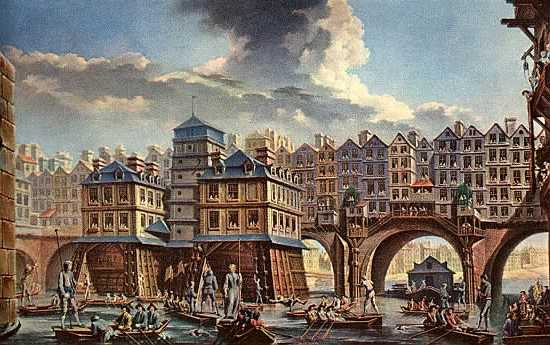
Quite possibly one of the largest stages of the project, second only to the new roads, was the architecture. To accompany the new streets and provide visual unity to the entire city, Haussmann and his team of architects constructed a unifying architectural façade that changed the shape of Paris. As well as coating the city with a unifying style, they also constructed new public buildings, such as L’Opéra , as well as many other buildings. During the 18th century and the time of the Enlightenment, “architects were no longer content to see their buildings glorify the state, the monarchy, or one specific stratum of society: they aspired to create monuments that would celebrate human greatness, inculcate worthy remembrance, teach moral values.” The buildings became expressive and mimicked nature, ignoring the classical norms they once followed. The Baroque and Rococo styles of architectural design were short lived, with people once again wanting a return to the historical classical style that was so prominent throughout Europe. By the fin of the 18th siecle, neoclassicism was becoming the dominant style in both painting and architecture. With the widening of the Parisian streets, Haussmann and his crew were able to add an extra story of height to the buildings that lined the roads. The additional height increased the amount of living space within the city limits, easing up on the overcrowding, but not changing the affordability of the housing. The change in height can be seen best in the apartment buildings found rampant throughout the city. They are noted by their simple decoration and adherence to the classical style. An emphasis on the horizontal can be seen in the façade, following the horizontal of the streets they sat next to, adding to the symmetry and geometric unity that Haussmann wanted the new Paris to have. By using a much more austere and “modern” style for the façade, the cost for the buildings could be kept low and the buildings would appear timeless in a changing city.
The apartment buildings were typically five stories with the ground floor and the in between floors having thick walls. The second story usually had a balcony with elaborate stonework, while the third and fourth floors resembled the second floor without the balcony. The fifth floor or top floor generally had an undecorated balcony that traveled the length of the building. The facades were also constructed out of large stone blocks, adding to the simplicity of the structure and the lack of decoration made the building seem larger than it actually was. Inspired by the Industrial Revolution, the new apartment buildings mimicked the products produced by the factories. Each item was the same and could be built quickly by those with only a small amount of knowledge of architecture or design. With the rise of the nouveux riches came the need for hôtels or living spaces for the rich within the city. Unlike the simple, austere apartment houses, no expense was spared on decoration and they were constructed in the most fashionable districts within Paris. They were not neoclassical in style like the apartments, but a mixture of early Renaissance and the ornate baroque style. The hôtels were symbols of wealth and status and the rising modernity in Paris.
Not only did Haussmann unify the apartment buildings throughout the city and build rich hiotels, but he also established a corps of architects for the city. They were responsible for designing all the municipal buildings throughout the city. From train stations to government offices, the project’s architects built interactive Neoclassical monuments that would stand proud in the city’s squares and emphasize the importance of modernity. Most notable are the train stations, which linked Paris to the rest of France. They were an integral part in the rise of the Parisian population, and also allowed not only the rich, but everyone, to take day trips and explore the countryside surrounding the city. The stations were simply designed, with a high central vault, adorned with glass and iron tracery, similar to that of the wheel that propels the train along. The train stations were tall and classical in style, decorated with arcades and balustrades, all while emphasizing the speed and power of the steam engine. To many, the trains represented the new modern time, recognized around the world as one of the greatest products of Industrialization.
L’Opéra Paris, designed by Charles Garnier, is known as one of the greatest public works to come out of this time period. Built in 1861, the opera house unifies not only the city and the quarter that it rests in, but the people of Paris as well. With the newfound industry and technology, the new rich now had free time and could enjoy things like traveling to the countryside for a day or taking in an afternoon performance. The new opera house gave them a place to go and be seen. The building itself is a neoclassical wonder, with Baroque elements, drawing influence from the reigns of previous French rulers. The façade of the building is divided into two levels. The lower entrance level has an arcade of arches adorned with sculpture, while the second level is faced with Corinthian paired columns. The building is adorned with carved decoration as well as a central dome that is richly decorated on the interior. Two smaller domes flank the wings of the building adding the magnificent grandeur of this richly detailed public building. It sits alone in a diamond, with three square plazas surrounding it, isolating the building and emphasizing its importance in modern life. The Paris Opera House is much more richly decorated than any other building built during this time period, but it catered to the rich and those with the time to come spend time within its walls. The building served no governmental purpose, but was instead a site of leisure and pleasure, preserved within its architectural design.16 It is seen even today as a symbol of the nouveux riches and the rise of modernity.
With this magnificent transformation of Paris into a modern city, came a big budget. According to the article “Money and Politics in the Rebuilding of Paris, 1860-1870,” Haussmann calculated in 1869 that the cost of rebuilding Paris since the project’s beginning in 1851 was to be 2,500,000,000 francs. “As an equivalent expenditure in New York City at present, forty-four times the expenditures in the budget of 1955-1956, would be $78,000,000,000!”17 Haussmann and Napoleon III did not forsee the project costing this much and had not raised the amount of money needed to pay for all of their construction. With the addition of new elements to the project, the budget only soared. Many people living in Paris during the time felt that Haussmann and crew had lied to them about the costs of the renovations and felt that the city had been paralyzed by the never ending construction. With the removal of Haussmann from his office as prefect of the Seine in 1870, the Third Republic took control of the government and the debts that Napoleon and Haussmann had gotten the city into.
Since the undertaking of the modernization of Paris in the 1850’s, Haussmann’s name has become ubiquitous with urban planning. With the help and approval of Napoleon III, Haussmann was able to transform an entire city in a period of twenty years. The once Medieval city was now a modern power house with room to grow. The redistricting of the city, building of new roads, monuments, public spaces and places, as well as new public works buildings and a new sewer system all added to the grandeur of the city. Haussmann not only improved the appearance of Paris, but also the health of the people. By widening the streets and building more housing, he eased the overcrowding and lowered the threat of disease. The new sewer system also helped create a cleaner Paris by channeling the waste water and human waste away from the city to ease on the smell and the dirt that would make Paris seem uncivilized. Haussmann’s new buildings proved to be more functional and stronger than the previous buildings in Paris. Georges Haussmann has become known as one of the first great urban planners in history and has inspired many others to take on such arduous tasks as rebuilding a preexisting city. And yet Haussmann’s greatest success was leaving us with a legacy known as Paris.
Works Cited
| |
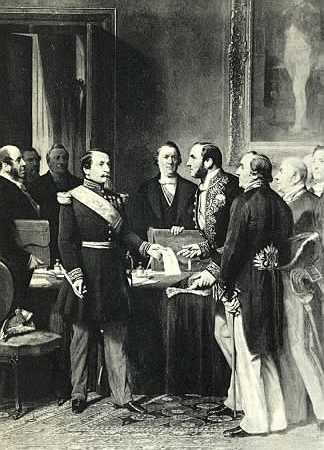
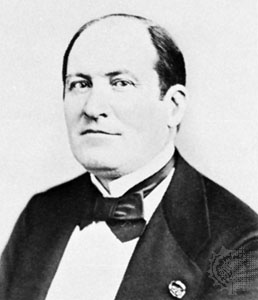 Napoleon had a keen interest in architecture and could often be found modifying the blueprints of Paris to include the roads that he wanted to construct. This interest in modifying the layout of the city would manifest itself into a project that would encompass all aspects of urban planning, from streets to sewers, and completely change the shape of Paris as everyone knew it. As stated by Anthony Sutcilffe in his book Paris: An Architectural History, the project “coincided with the first surge of French industrialization, beginning in the 1840s and lasting until the Great Depression of the 1870s.”
Napoleon had a keen interest in architecture and could often be found modifying the blueprints of Paris to include the roads that he wanted to construct. This interest in modifying the layout of the city would manifest itself into a project that would encompass all aspects of urban planning, from streets to sewers, and completely change the shape of Paris as everyone knew it. As stated by Anthony Sutcilffe in his book Paris: An Architectural History, the project “coincided with the first surge of French industrialization, beginning in the 1840s and lasting until the Great Depression of the 1870s.”
